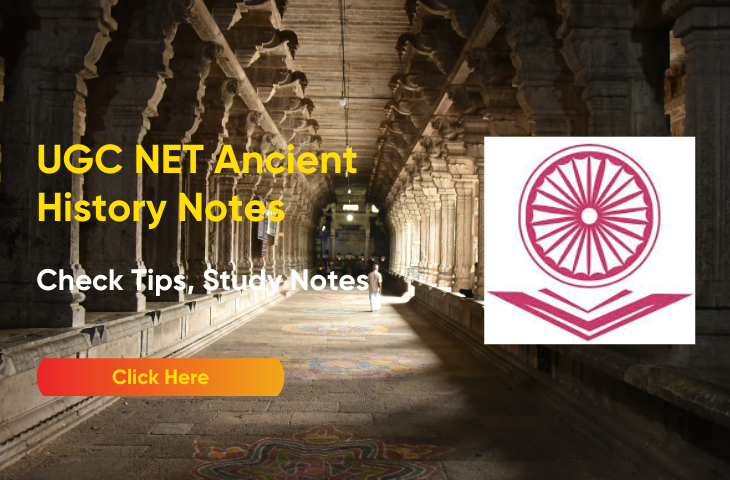If you are preparing for UGC NET History, than we have come up with the UGC NET Ancient History Study Notes will help you decode the past with precision! Ancient India witnessed the rise of the Indus Valley Civilization (2600–1900 BCE), known for its advanced urban planning, followed by the Vedic Age, which laid the foundation for Hindu philosophy. The Mauryan Empire (321–185 BCE) saw the legendary rule of Ashoka, while the Gupta Empire (319–550 CE) ushered in the “Golden Age” of art, science, and literature. From Ashoka’s dhamma to Aryabhata’s zero, mastering these historical milestones is key to acing the exam. Dive in and strengthen your preparation.
UGC NET Ancient History Notes Weightage & PYQ Analysis
Understanding the weightage and trends of the Ancient History section in the UGC NET exam is crucial for effective preparation. Here’s a concise analysis based on recent data:
Weightage Overview:
- Ancient Indian History: Approximately 20% of the UGC NET History Paper II.
PYQ Trends:
- Indus Valley Civilization & Vedic Age: 1-2 questions per exam.
- Mauryan & Gupta Empires: 2-3 questions per exam.
- Buddhism & Jainism: 1-2 questions per exam.
- Archaeological Sources & Literary Evidence: 1 question per exam.
- Miscellaneous: 2 question per exam
Topic Wise UGC NET Ancient History Study Notes of India
| Topic | Study Notes Link |
| Archaeological Sources | Study Notes |
| Exploration and Excavation | Study Notes |
| Epigraphy and Numismatics | Study Notes |
| Dating of Archaeological Sites | Study Notes |
| Indigenous Literature | Study Notes |
| Problem of Dating Religious & Secular Literature | Study Notes |
| Myths and Legends | Study Notes |
| Foreign Accounts | Study Notes |
| Pastoralism and Food Production | Study Notes |
| Neolithic and Chalcolithic Phase | Study Notes |
| Settlement Patterns | Study Notes |
| Tools and Patterns of Exchange | Study Notes |
| Indus/Harappa Civilization | Study Notes |
| Origin and Extent of Indus Civilization | Study Notes |
| Major Sites of Indus Civilization | Study Notes |
| Craft Specialization in Indus Civilization | Study Notes |
| Religion and Society in Indus Civilization | Study Notes |
| Polity of Indus Civilization | Study Notes |
| Decline of Indus Civilization | Study Notes |
| Internal and External Trade | Study Notes |
| First Urbanization in India | Study Notes |
| Vedic Period | Study Notes |
| Later Vedic Period | Study Notes |
| Aryan Debates | Study Notes |
| Political and Social Institutions | Study Notes |
| State Structure and Theories of State | Study Notes |
| Emergence of Varnas and Social Stratification | Study Notes |
| Religious and Philosophical Ideas | Study Notes |
| Introduction of Iron Technology | Study Notes |
| Megaliths of South India | Study Notes |
| Expansion of State System | Study Notes |
| Mahajanapadas | Study Notes |
How to Prepare for UGC NET Ancient History Effectively?
Cracking the UGC NET Ancient History exam requires a strategic approach with the right resources and practice. Follow these expert tips to boost your preparation:
Refer to Standard Books (Best Books for UGC NET Ancient History)
- R.S. Sharma – Ancient India (Comprehensive insights into early Indian history)
- Upinder Singh – A History of Ancient and Early Medieval India (Covers archaeological sources in detail)
- Romila Thapar – Early India (Deep analysis of political and cultural history)
Analyze Previous Year Question Papers (PYQs)
- Identify frequently asked topics like the Indus Valley Civilization, Mauryan Administration, Gupta Economy, Buddhism & Jainism.
- Focus on conceptual clarity and factual recall.
Revise with Mind Maps & Flashcards
- Summarize key topics like Vedic Period, Political Institutions, Trade & Economy for quick revision.
- Use flowcharts to understand dynastic transitions and administrative systems.
Practice MCQs & Mock Tests (Improve Accuracy & Speed)
- Attempt UGC NET History mock tests to analyze your strengths & weaknesses.
- Solve topic-wise MCQs to master factual and analytical questions.
Stay consistent, revise smartly, and practice regularly to ace the UGC NET History exam!
Also Check: UGC NET History Notes for 2025 Study Material PDF Download
UGC NET Ancient History Notes of India Conclusion
Ancient Indian History is a high-scoring section if approached strategically. With a clear understanding of sources, civilizations, polity, economy, and culture, you can effectively tackle UGC NET History questions. Prioritize PYQs, go through the notes revise concepts regularly, and practice multiple-choice questions for exam success.
Also Check: UGC NET History Syllabus 2025, Download PDF
UGC NET Ancient History Notes FAQs
Ans: On average, 20% questions are asked from Ancient Indian History in the UGC NET History paper.
Ans: Key topics include:
– Indus Valley Civilization (Sites, Economy, Society)
– Vedic Age (Early & Later Vedic Period)
– Mauryan & Gupta Empires (Administration, Economy, Art & Architecture)
– Buddhism & Jainism (Philosophy, Growth, Decline)
– Sources of Ancient Indian History (Archaeological & Literary Sources)
Ans: You can access topic-wise free study material for UGC NET Ancient History on Oliveboard preparation platforms.
Ans: 1. Use mind maps for dynasties and administrative structures.
2. Make flashcards for key terms, inscriptions, and sources.
3. Solve PYQs to understand exam patterns.
4. Attempt mock tests for time management.

Hello there! I’m a dedicated Government Job aspirant turned passionate writer & content marketer. My blogs are a one-stop destination for accurate and comprehensive information on exams like Regulatory Bodies, Banking, SSC, State PSCs, and more. I’m on a mission to provide you with all the details you need, conveniently in one place. When I’m not writing and marketing, you’ll find me happily experimenting in the kitchen, cooking up delightful treats. Join me on this journey of knowledge and flavors!
